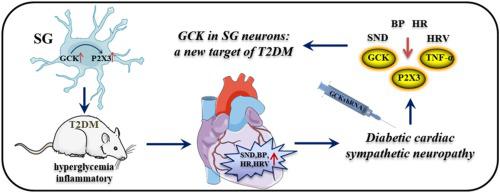Brain Research Bulletin ( IF 3.5 ) Pub Date : 2020-10-20 , DOI: 10.1016/j.brainresbull.2020.10.004 Xiumei Xu 1 , Baoe Liu 2 , Jingjian Yang 2 , Yuting Zou 2 , Minghao Sun 2 , Zijing Li 2 , Lin Li 1 , Runan Yang 1 , Lifang Zou 1 , Guilin Li 1 , Shuangmei Liu 1 , Guodong Li 1 , Shangdong Liang 1

|
Glucokinase (GCK) may be involved in inflammatory pathological changes, while the P2X3 receptor in the stellate ganglia (SG) is related to diabetic cardiac autonomic neuropathy. In this study, we explored the relationship between the upregulated GCK in SG and diabetic cardiac sympathy. The expression and location of GCK and P2X3 in SG of type 2 diabetes mellitus (T2DM) rats were assessed. Changes in cardiac function were determined by measuring blood pressure, sympathetic nerve activity, heart rate, and heart rate variability. P2X3 agonist-activated currents in isolated stellate ganglion neurons and cultured human embryonic kidney 293 (HEK293) cells were recorded using whole-cell patch clamp techniques. The upregulated expression of GCK in SG of T2DM rats was decreased after treatment with GCK short hairpin RNA (shRNA). GCK shRNA treatment also improved the blood pressure, sympathetic nerve activity, heart rate, and heart rate variability in T2DM rats. By contrast, the expression of P2X3 and tumor necrosis factor α (TNF-α) was lessened by GCK shRNA treatment. In addition, adenosine triphosphate (ATP)-activated currents in stellate ganglion neurons and HEK293 cells co-transfected with GCK and P2X3 receptor plasmids were reduced after GCK shRNA treatment. In T2DM rats, knockdown of GCK relieved the diabetic cardiac sympathy mediated by P2X3 receptor-involved upregulation of GCK in SG.
中文翻译:

星状神经节中的葡萄糖激酶与 P2X3 受体协同发展 2 型糖尿病大鼠心脏交感神经病变
葡萄糖激酶(GCK)可能参与炎症病理改变,而星状神经节(SG)中的P2X3受体与糖尿病心脏自主神经病变有关。在这项研究中,我们探讨了 SG 中上调的 GCK 与糖尿病心脏交感之间的关系。评估 GCK 和 P2X3 在 2 型糖尿病 (T2DM) 大鼠 SG 中的表达和位置。通过测量血压、交感神经活动、心率和心率变异性来确定心脏功能的变化。使用全细胞膜片钳技术记录分离的星状神经节神经元和培养的人胚胎肾 293 (HEK293) 细胞中 P2X3 激动剂激活的电流。用GCK短发夹RNA(shRNA)治疗后,T2DM大鼠SG中GCK的上调表达降低。GCK shRNA 治疗还改善了 T2DM 大鼠的血压、交感神经活动、心率和心率变异性。相比之下,GCK shRNA 治疗降低了 P2X3 和肿瘤坏死因子α(TNF-α)的表达。此外,GCK shRNA 处理后,星状神经节神经元和与 GCK 和 P2X3 受体质粒共转染的 HEK293 细胞中三磷酸腺苷 (ATP) 激活的电流减少。在 T2DM 大鼠中,GCK 的敲低减轻了由 P2X3 受体参与的 SG 中 GCK 上调介导的糖尿病心脏交感神经。GCK shRNA 处理后,星状神经节神经元和与 GCK 和 P2X3 受体质粒共转染的 HEK293 细胞中三磷酸腺苷 (ATP) 激活的电流降低。在 T2DM 大鼠中,GCK 的敲低减轻了由 P2X3 受体参与的 SG 中 GCK 上调介导的糖尿病心脏交感神经。GCK shRNA 处理后,星状神经节神经元和与 GCK 和 P2X3 受体质粒共转染的 HEK293 细胞中三磷酸腺苷 (ATP) 激活的电流降低。在 T2DM 大鼠中,GCK 的敲低减轻了由 P2X3 受体参与的 SG 中 GCK 上调介导的糖尿病心脏交感神经。











































 京公网安备 11010802027423号
京公网安备 11010802027423号